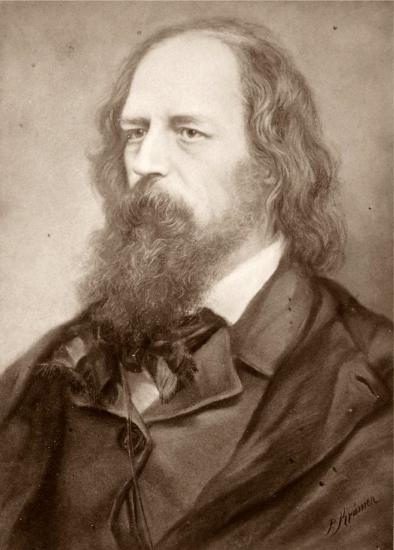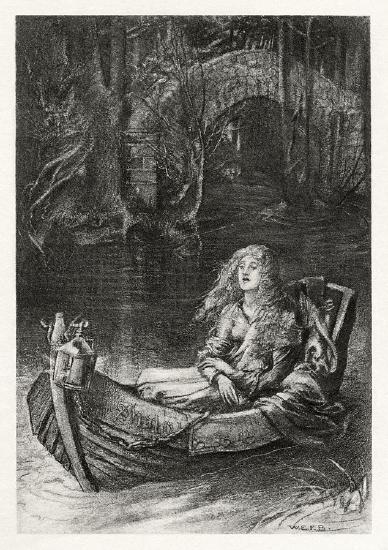7.23: Tennyson, Alfred Lord. "The Lady of Shalott" (1832)
- Page ID
- 40449
Author Biography
Alfred Lord Tennyson (1809-1892) is one of the most prominent English poets and is, even today, both read and cherished by a big audience. Tennyson's early writing is clearly inspired by the Romantic tradition, though most of his work was published during the Victorian period. "The Lady of Shalott" is one of his most famous poems, and was published in Tennyson's first collection of poems in 1832.

This image of Alfred Lord Tennyson is in the public domain
Like so many writers and poets, Tennyson took little interest in his school work and studies. He went to Cambridge, but he idled through his studies and never took a degree. He sought company with friends who inspired him and encouraged him to follow his poetic vocation. However, his early writing was not given much esteem by his contemporary critics. But Tennyson was determined to succeed and was indefatigably working to perfect his art. During the 1840s, he gradually won the acclaim of the reading public, and in 1850 he was appointed Poet Laureate by Queen Victoria; a prestigious honor to be bestowed on a living poet. (Tennyson succeeded William Wordsworth as Poet Laureate). Tennyson was very productive during his later life; he was a versatile writer with a wide horizon. His writing includes poems, drama, essays, and religious and philosophical reflections. His popularity and his contribution to Victorian literature have given him an undisputable position in English literary tradition.
"The Lady of Shalott" (1832)

"Illustration to Tennyson's 'The Lady of Shalott'" by W. E. F. Britten (1901) is in the public domain
I
On either side the river lie
Long fields of barley and of rye,
That clothe the wold and meet the sky;
And through the field the road runs by
To many-tower'd Camelot;
And up and down the people go,
Gazing where the lilies blow
Round an island there below,
The island of Shalott,
Willows whiten, aspens quiver,
Little breezes dusk and shiver
Through the wave that runs for ever
By the island in the river
Flowing down to Camelot.
Four gray walls, and for gray towers
Overlook a space of flowers,
And the silent isle embowers
The Lady of Shalott.
By the margin, willow-veil'd,
Slide the heavy barges trail'd
By slow horses; and unhail'd
The shallop flitteth silken-sail'd
Skimming down to Camelot:
But who hath seen her wave her hand?
Or at the casement seen her stand?
Or is she known in all the land,
The Lady of Shalott?
Only reapers, reaping early
In among the bearded barley,
Hear a song that echoes cheerly
From the river winding clearly
Down to tower'd Camelot:
And by the moon the reaper weary,
Piling sheaves in uplands airy,
Listening, whispers, "'Tis the fairy
Lady of Shalott.
II
There she weaves by night and day
A magic web with colours gay.
She has heard a whisper say
A curse is on her if she stay
To look down on Camelot.
She know not what the curse may be
And so she weaveth steadily,
And little other care hath she,
The Lady of Shalott.
And moving through a mirror clear
That hangs before her all the year,
Shadows of the world appear.
There she sees the highway near
Winding down to Camelot:
There the river eddy whirls,
And there the surly village-churls
And the red cloaks of market girls,
Pass onward from Shalott.
Sometimes a troop of damsels glad,
An abbot on an ambling pad,
Sometimes a curly shepherd-lad,
Or long-haired page in crimson clad,
Goes by to tower'd Camelot;
And sometimes through the mirror blue
The knights come riding two and two;
She hath no loyal knight and true,
The Lady of Shalott.
But in her web she still delights
To weave the mirror's magic sights,
For often through the silent nights
A funeral with plumes and lights
And music, went to Camelot:
Or when the moon was overhead,
Came two young lovers lately wed;
"I am half sick of shadows," said
The Lady of Shalott.
III
A bow-shot from her bower-eaves,
He rode between the barley-sheaves,
The sun came dazzling through the leaves
And flamed upon the brazen greaves
Of bold Sir Lancelot.
A red-cross knight for ever kneel'd
To a lady in his shield,
That sparkled on the yellow field,
Beside remote Shalott.
The gemmy bridle glittered free,
Like to some branch of stars we see
Hung in the golden Galaxy.
The bridle bells rang merrily
As he rode down to Camelot.
And from his blazon'd baldric slung
A mighty silver bugle hung,
And as he rode his armour rung,
Beside remote Shalott.
All in the blue unclouded weather
Thick-jewelled shone the saddle-leather;
The helmet and the helmet feather
Burned like one burning flame together.
As he rode down to Camelot.
As often through the purple night,
Below the starry clusters bright,
Some bearded meteor, trailing light,
Moves over still Shalott.
His broad clear brow in sunlight glowed;
On burnished hooves his war-horse trode;
From underneath his helmet flowed
His coal-black curls as on he rode,
As he rode down to Camelot.
From the bank and from the river
He flashed into the crystal mirror;
"Tirra lirra" by the river
Sang Sir Lancelot.
She left the web, she left the loom,
She made three paces through the room,
She saw the water-lily bloom,
She saw the helmet and the plume,
She looked down to Camelot.
Out flew the web and floated wide;
The mirror cracked from side to side;
"The curse is come upon me," cried
The Lady of Shalott.
IV
In the stormy east-wind straining,
The pale yellow woods were waning,
The broad stream in his banks complaining,
Heavily the low sky raining
Over tower'd Camelot;
Down she came and found a boat
Beneath a willow left afloat,
And round about the prow she wrote
The Lady of Shalott.
And down the river's dim expanse –
Like some bold seer in trance,
Seeing all his own mischance –
With a glassy countenance
Did she look to Camelot.
And at the closing of the day
She loosed the chain, and down she lay;
The broad stream bore her far away,
The Lady of Shalott.
Lying, robed in snowy white
That loosely flew to left and right –
The leaves upon her falling light –
Through the noises of the night
As she floated down to Camelot:
And as the boat-head wound along
The willowy hills and fields among,
They heard her singing her last song,
The Lady of Shalott.
Heard a carol, mournful, holy,
Chanted loudly, chanted lowly,
Till her blood was frozen slowly,
And her eyes were darken’d wholly,
Turned to tower'd Camelot.
For ere she reached upon the tide
The first house by the water-side,
Singing in her song she died,
The Lady of Shalott.
Under tower and balcony,
By garden-wall and gallery,
A gleaming shape she floated by,
Dead-pale between the houses high,
Silent into Camelot.
Out upon the wharfs they came,
Knight and burgher, lord and dame,
And round the prow they read her name,
The Lady of Shalott.
Who is this? And what is here?
And in the lighted palace near
Died the sound of royal cheer;
And they crossed themselves for fear,
All the knights at Camelot;
But Lancelot mused a little space;
He said, "She has a lovely face;
God in his mercy lend her grace,
The Lady of Shalott".
Exercise 7.23.1
Understanding the Poem
- Rather than trying to understand the full poetic narrative word by word, it may be more fruitful, to begin with, to take in the atmosphere and the use of legendary references. What elements do you think create the mystic and fairy tale-like atmosphere? Which old legend does the poem refer to?
- The poem contains a number of archaic (old and obsolete) words that add to the feeling of a mystic and legendary past. Point out some examples of such words; how would they sound today?
- The poem is divided into four parts. What information do we get in each part? How does the narrative develop during the different parts of the poem?
- The rhyming and rhythmic patterns of the poem come alive when the poem is read out loud. Give some examples of how repetition and alliteration are essential elements.
- Find the rhyming pattern of the poem and check if the poet sticks to it all the way through. Do you think that a rhyming structure is an important element of poetry in general? Why/why not?
- Pay attention to the line structure of the poem. What is the effect of the indentation of lines five and nine in each stanza?
- There are many common poetic symbols in the poem (the loom, weaving, a river, an island in the river, a mirror, a curse, etc.) Discuss an interpretation of these symbols both in general and in this poem particularly.
- Where do we find traces of romantic and gothic themes and imagery in the poem?
- What is a "red-cross knight"?
- This is a quite physical poetic narrative with a distinct setting. Point out some descriptions of landscape, the island, the weather, the looks of the characters, and colors and sounds.
- Tennyson presumed that his readers were familiar with the legend of King Arthur, Sir Lancelot, and Camelot – are you? If not, you may want to search the net for information about this famous legend in English history. (Note that The Lady of Shalott does not appear in the legend, but The Lady of Astolat, Sir Lancelot, and Camelot do in Tennyson’s poem – what is the effect of that allusion?)
Contributors and Attributions
- Adapted from "A.L.Tennyson: The Lady of Shalott," Writer: Jan-Louis Nagel, Provided by NDLA, CC CC-BY-SA-4.0


